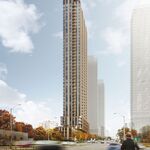reaperexpress
Senior Member
Do you have examples of curbside BRT? It sounds too much like diamond lanes to me, which depend on unreliable police enforcement. At the miminum, I would expect concrete barriers or bollards separating a curbside BRT lane from cars, so that:
- cars can never enter the BRT lane
- delivery trucks can't park in the BRT lane
- taxis can't idle in the BRT lane
Curbside BRT would seem to do the same thing to right-turns that median BRT would do to left-turns.
Riding Viva on Yonge north of Finch leaves me disenchanted with diamond lanes.
Curbside BRT can work if there isn't too much traffic turning right. Try route 196 on Allen Road/Dufferin Street. However that is using former HOV lanes, and the markings are not very noticeable. It still works though. At rush hour, buses fly by the cars.




